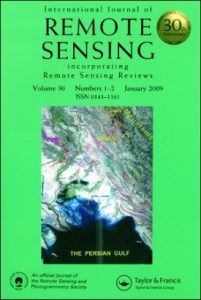 SOUTHWORTH, BUNTING – Dynamics of the relationship between NDVI and SWIR32 vegetation indices in southern Africa: implications for retrieval of fractional cover from MODIS data
SOUTHWORTH, BUNTING – Dynamics of the relationship between NDVI and SWIR32 vegetation indices in southern Africa: implications for retrieval of fractional cover from MODIS data
Michael J. Hill, Qiang Zhou, Qingsong Sun, Crystal B. Schaaf, Jane Southworth, Niti B. Mishra, Cerian Gibbes, Erin Bunting, Thomas B. Christiansen. & Kelley A. Crews
Article first published online: 02 Mar 2016 International Journal of Remote Sensing
DOI: 10.1080/01431161.2016.1154225
ABSTRACT: Fractional cover of photosynthetic vegetation (FPV), non-photosynthetic vegetation (FNPV), and bare soil (FBS) has been retrieved for Australian tropical savannah based on linear unmixing of the two-dimensional response envelope of the normalized difference vegetation index (NDVI) and short wave infrared ratio (SWIR)32 vegetation indices (VI) derived from Moderate Resolution Imaging Spectroradiometer (MODIS) reflectance data. The approach assumes that cover fractions are made up of a simple mixture of green leaves, senescent leaves, and bare soil. In this study, we examine retrieval of fractional cover using this approach for a study area in southern Africa with a more complex vegetation structure. Region-specific end-members were defined using Hyperion images from different locations and times of the season. These end-members were applied to a 10-year time series of MODIS-derived NDVI and SWIR32 (from 2002 to 2011) to unmix FPV, FNPV, and FBS. Results of validation with classified high-resolution imagery indicated major bias in estimation of FNPV and FBS, with regression coefficients for predicted versus observed data substantially less than 1.0 and relatively large intercept values. Examination with Hyperion images of the inverse relationship between the MODIS-equivalent SWIR32 index and the Hyperion-derived cellulose absorption index (CAI) to which it nominally approximates revealed: (1) non-compliant positive regression coefficients for certain vegetation types; and (2) shifts in slope and intercept of compliant regression curves related to day of year and geographical location. The results suggest that the NDVI–SWIR32 response cannot be used to approximate the NDVI–CAI response in complex savannah systems like southern Africa that cannot be described as simple mixtures of green leaves, dry herbaceous material high in cellulose, and bare soil. Methods that use a complete set of multispectral channels at higher spatial resolution may be needed for accurate retrieval of fractional cover in Africa.
Read the full publication at International Journal of Remote Sensing